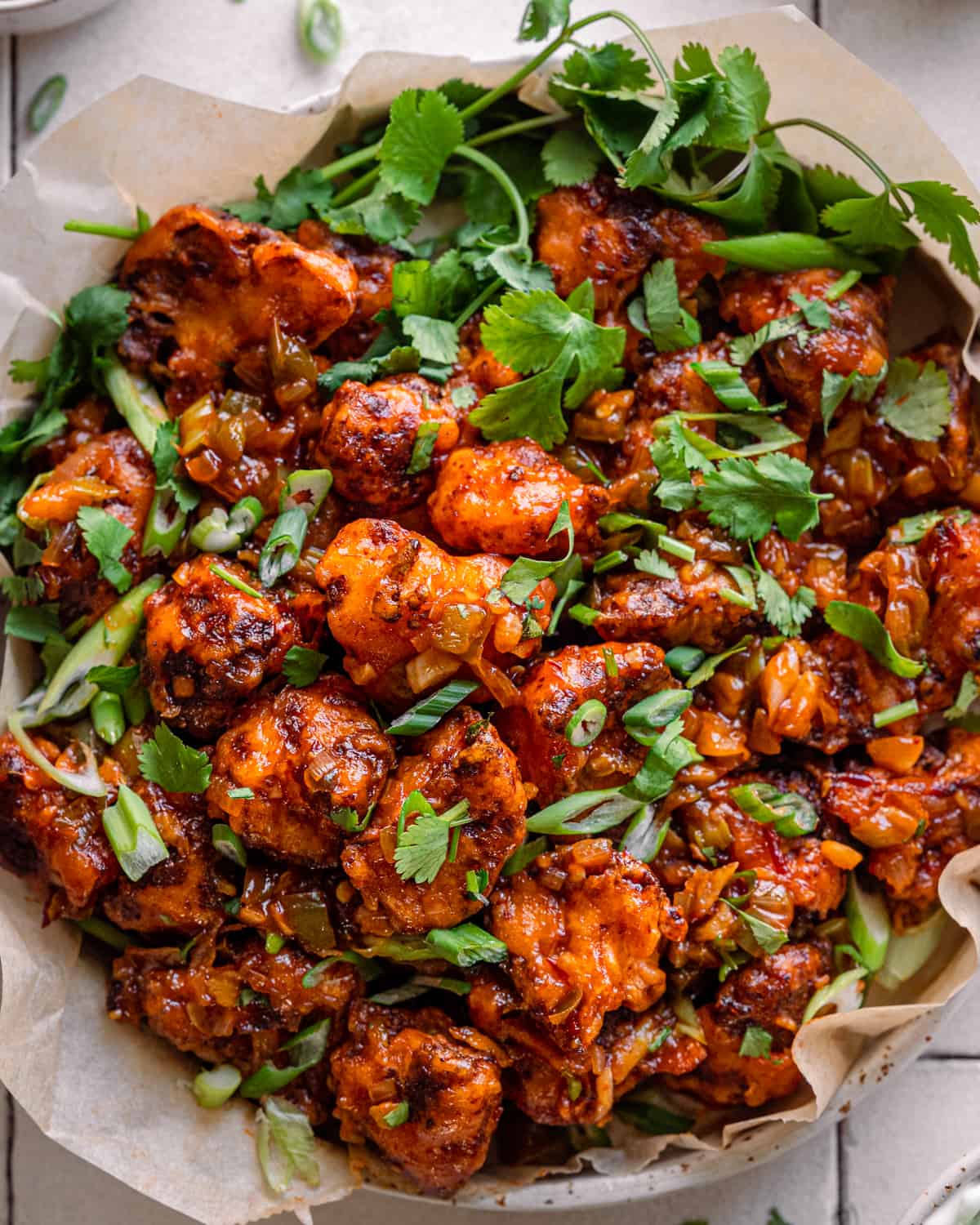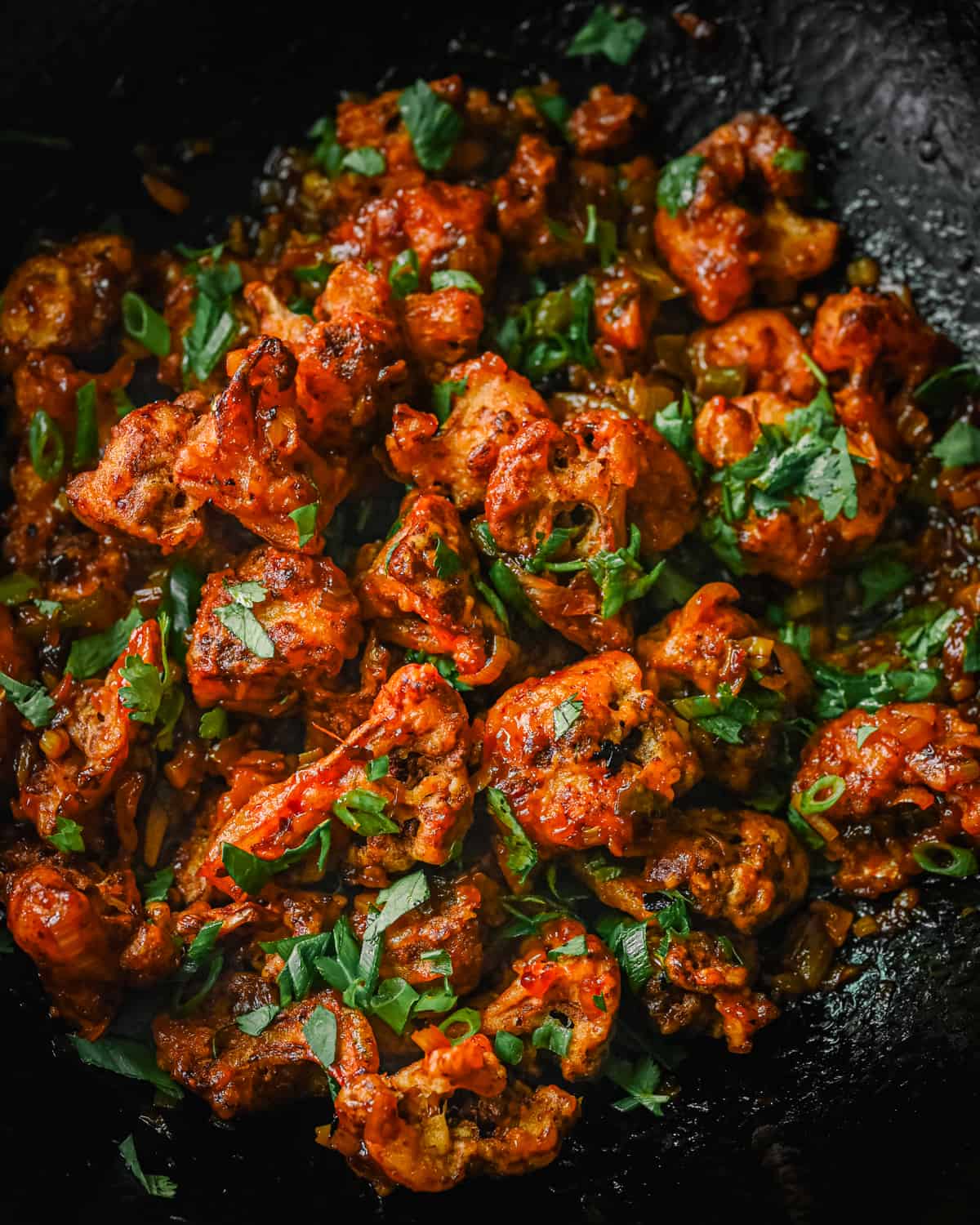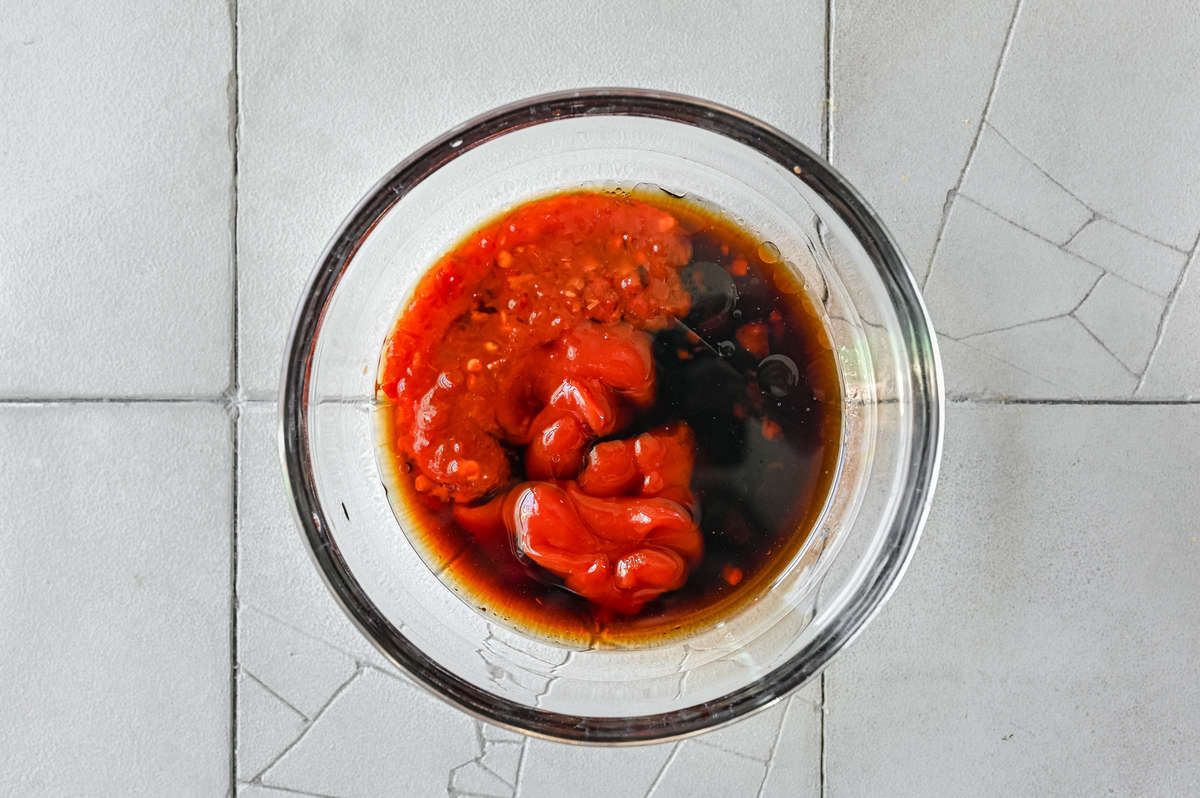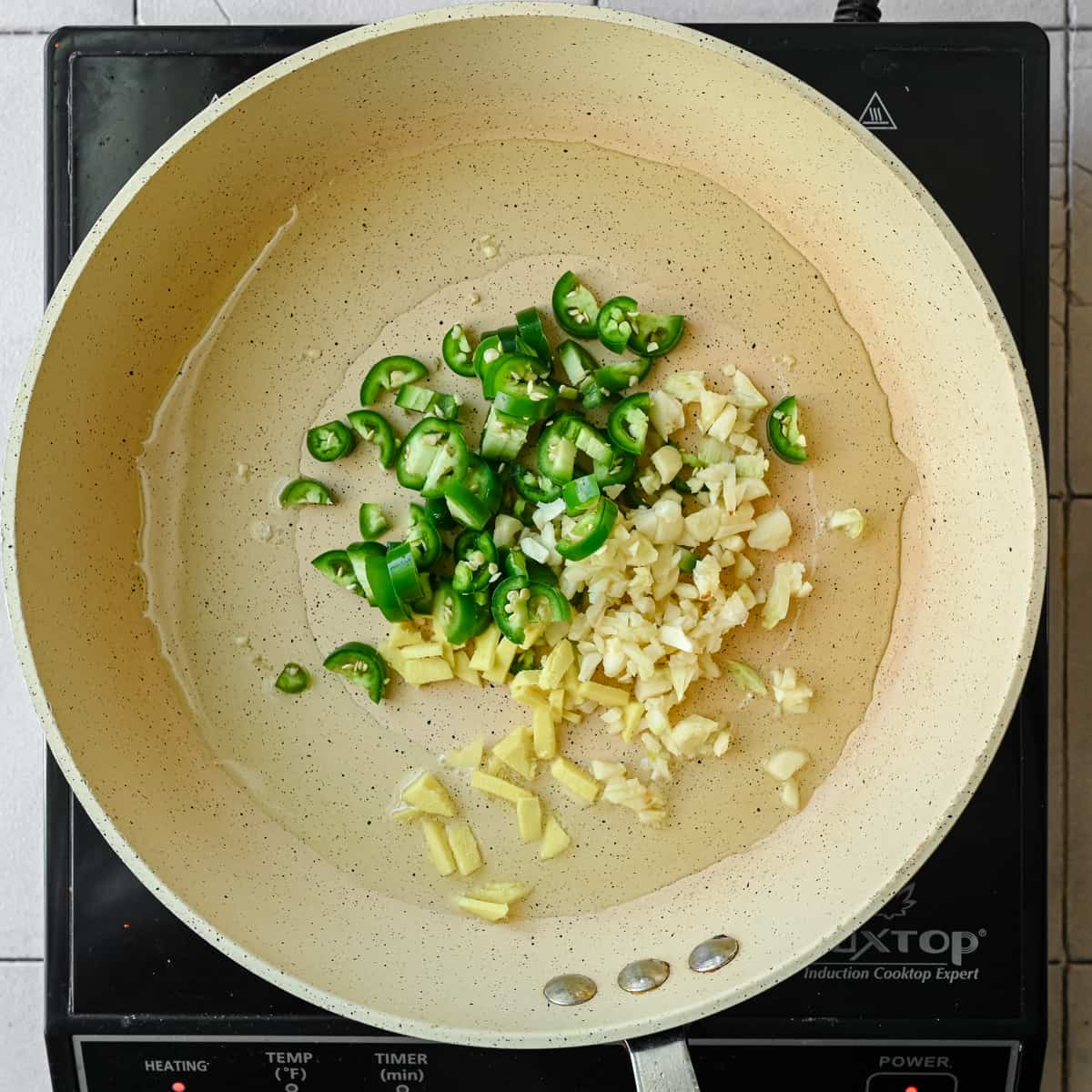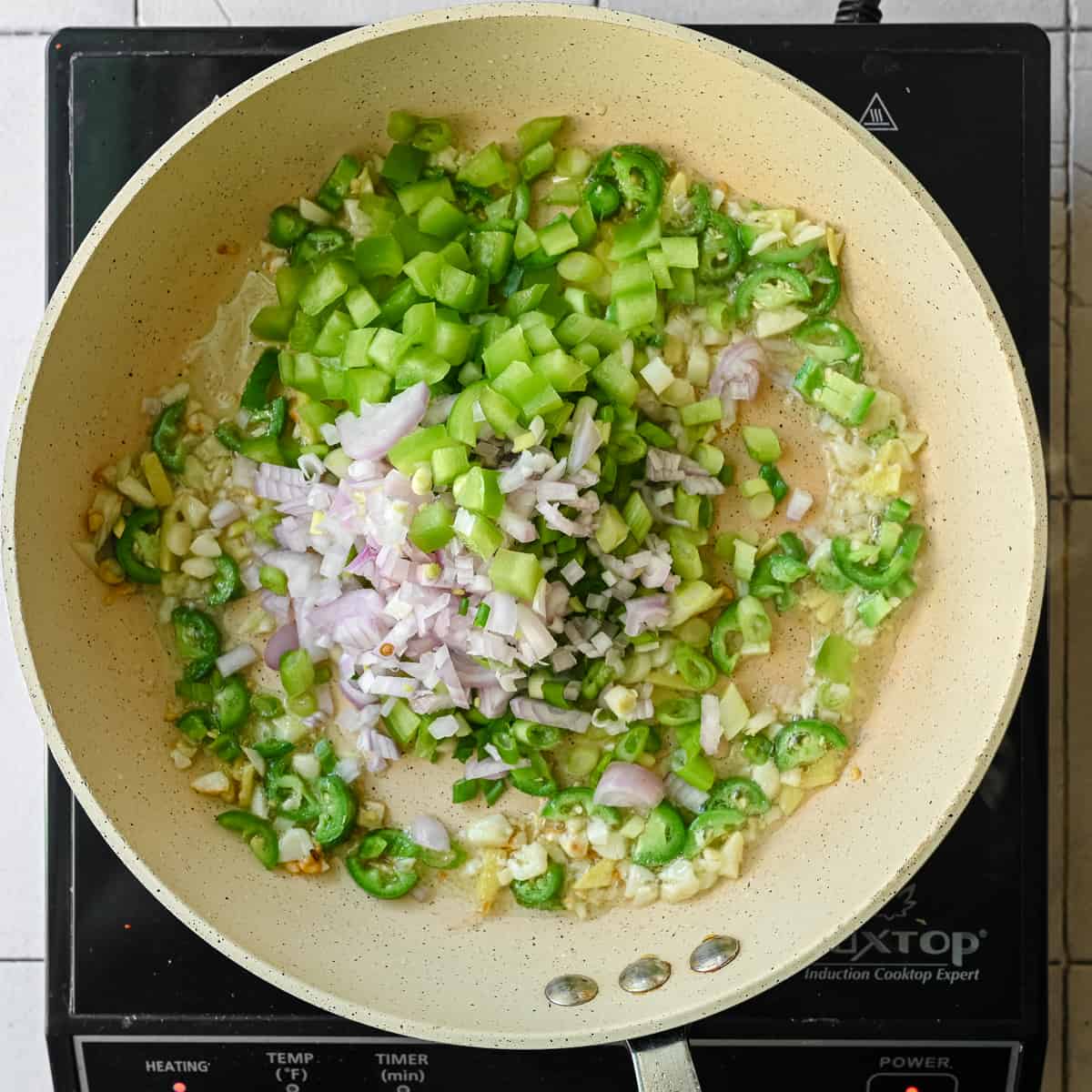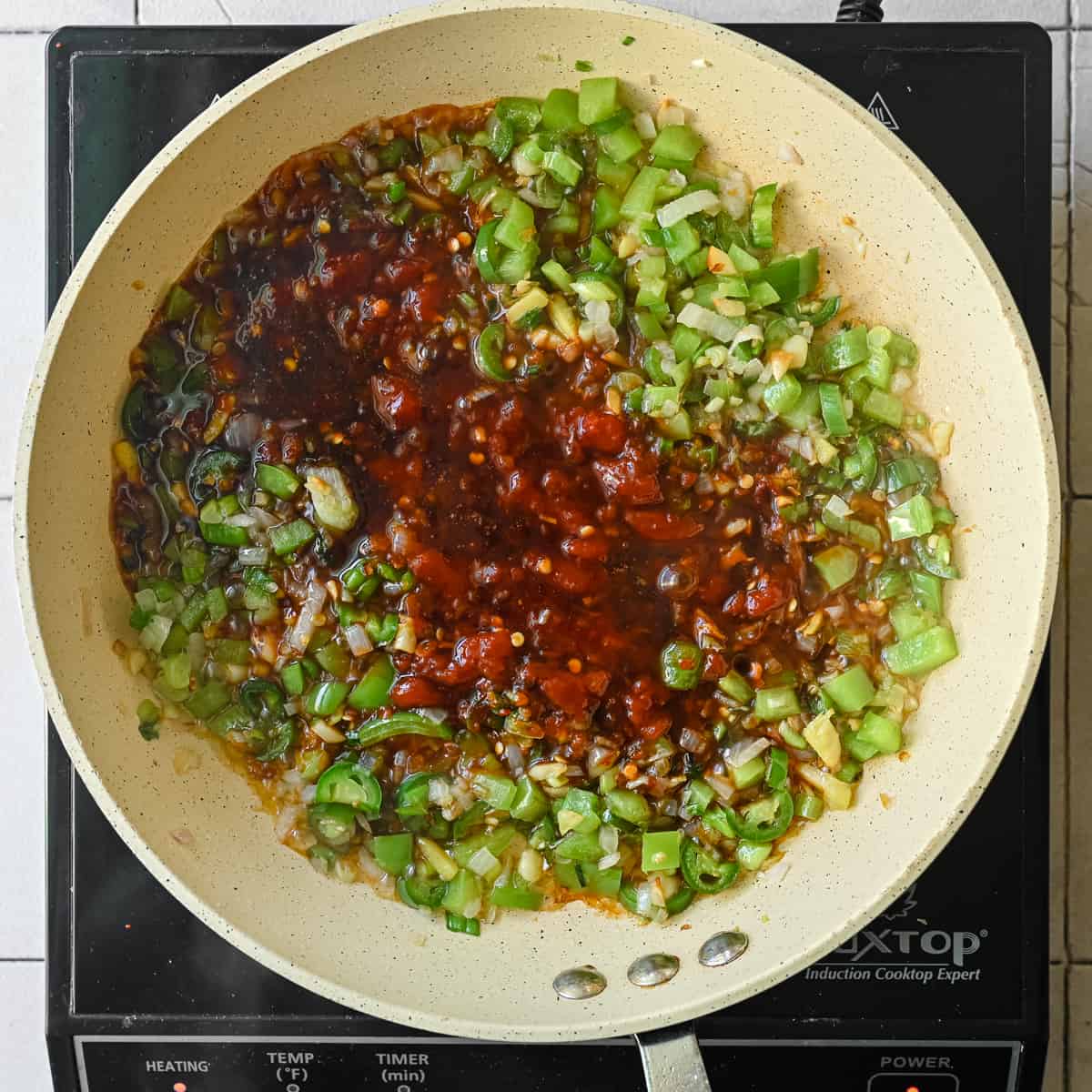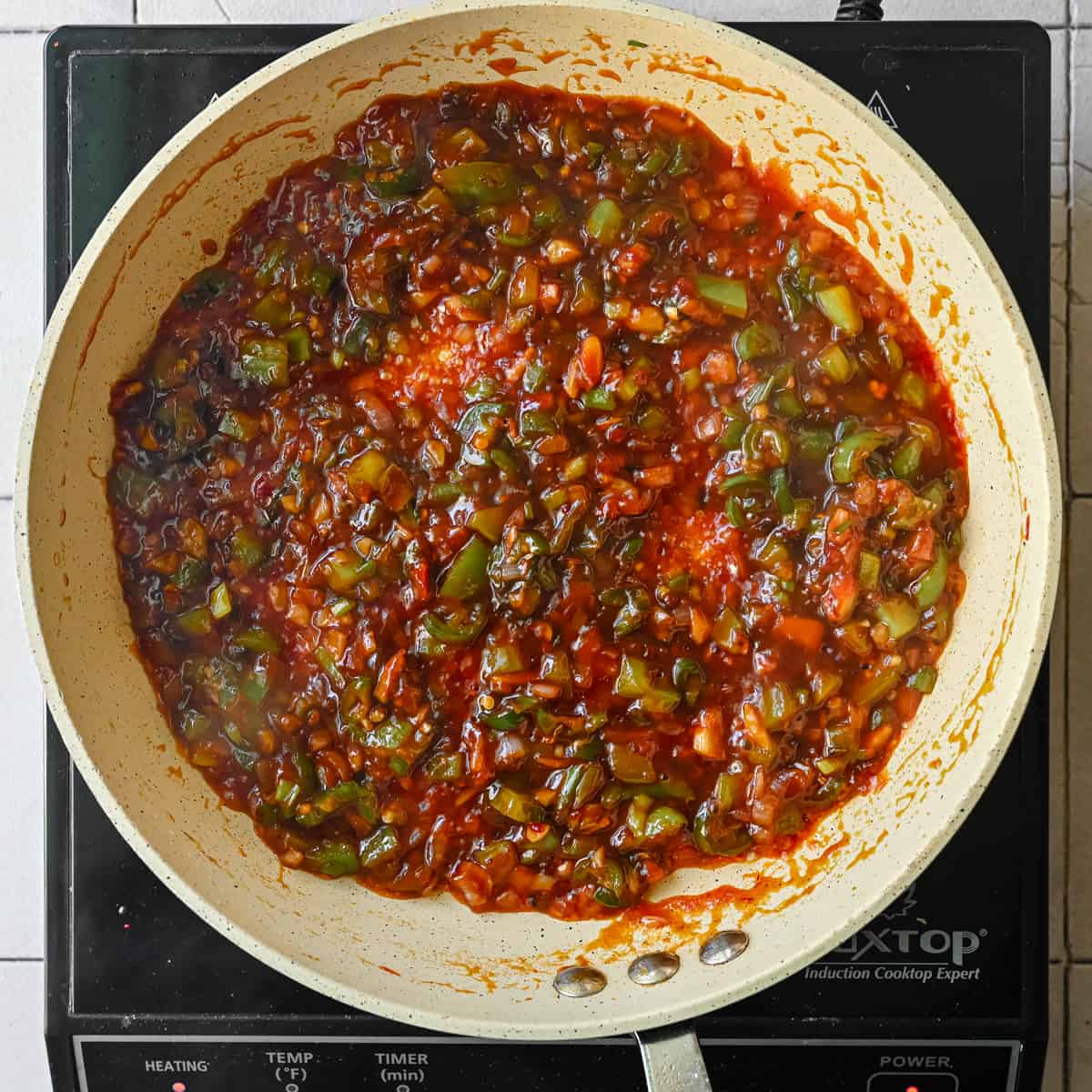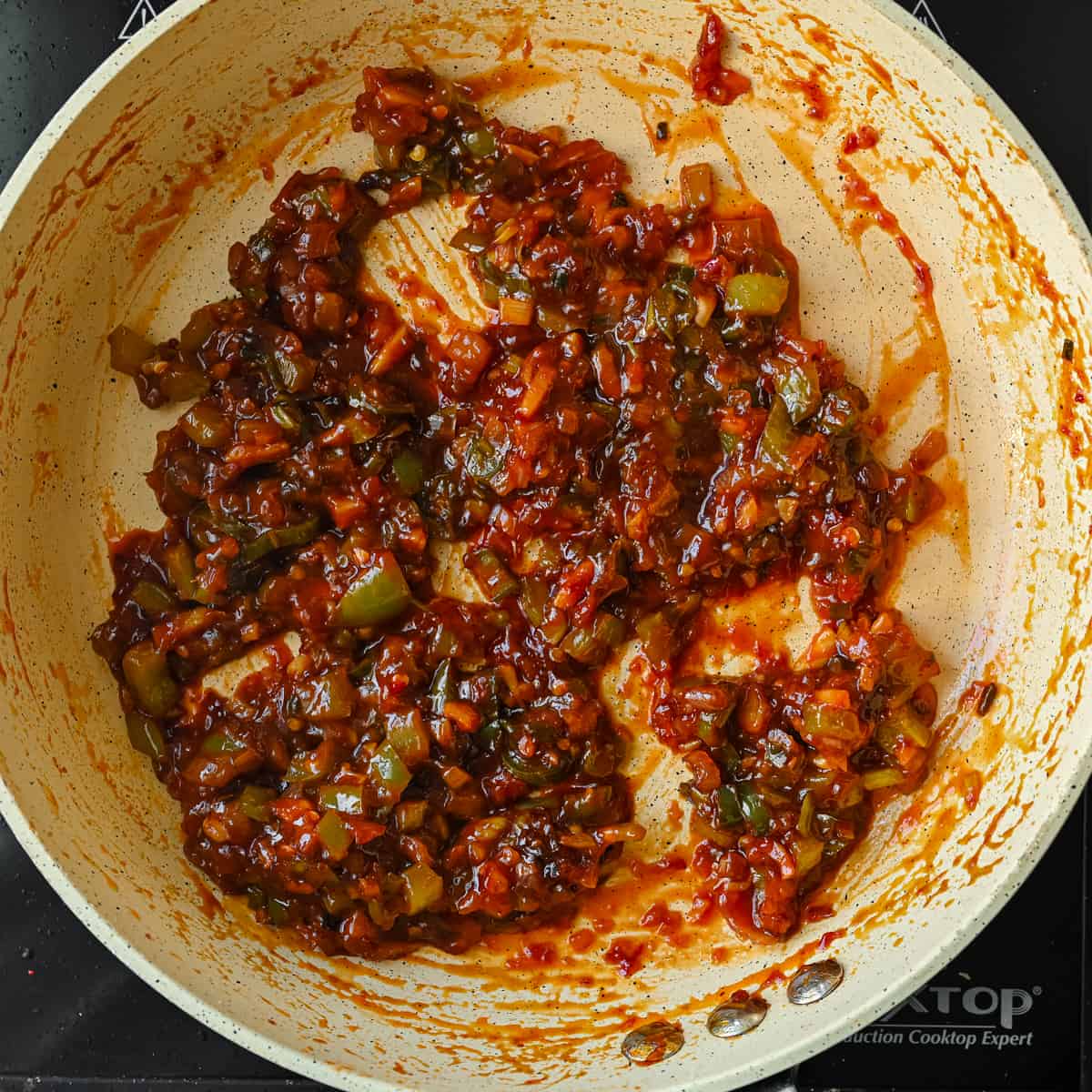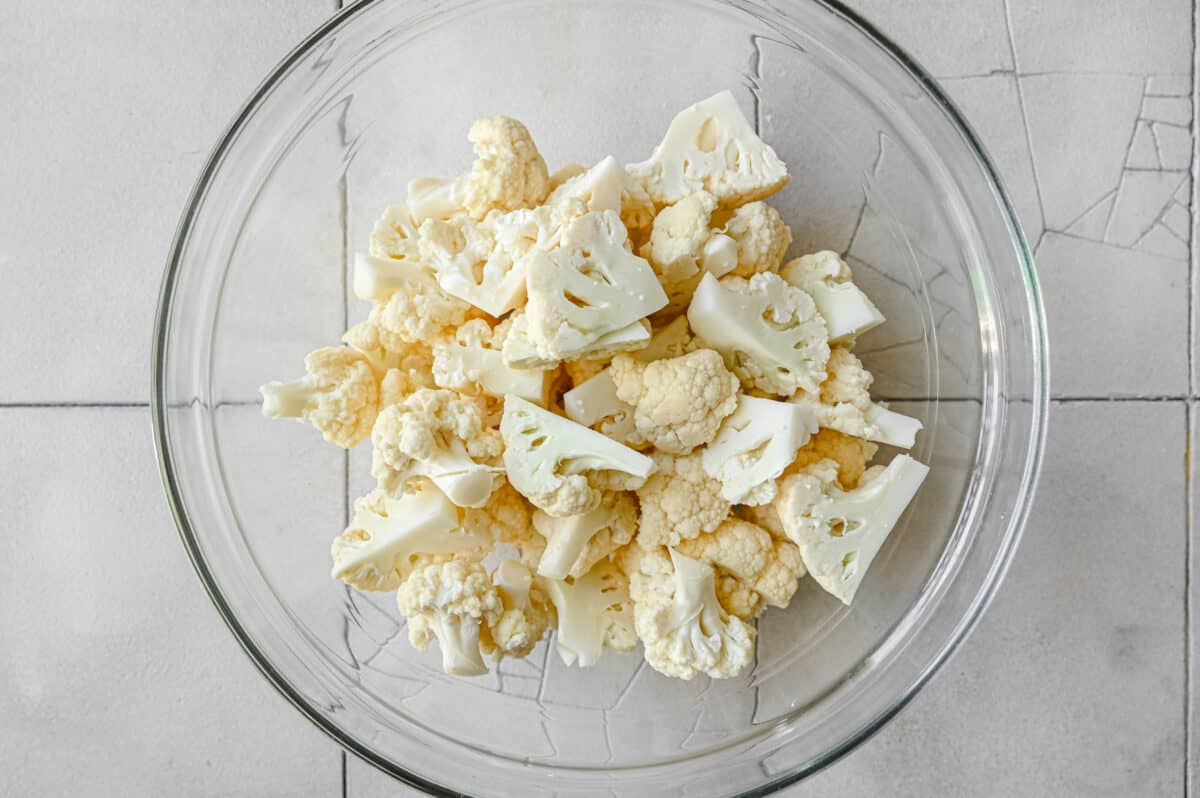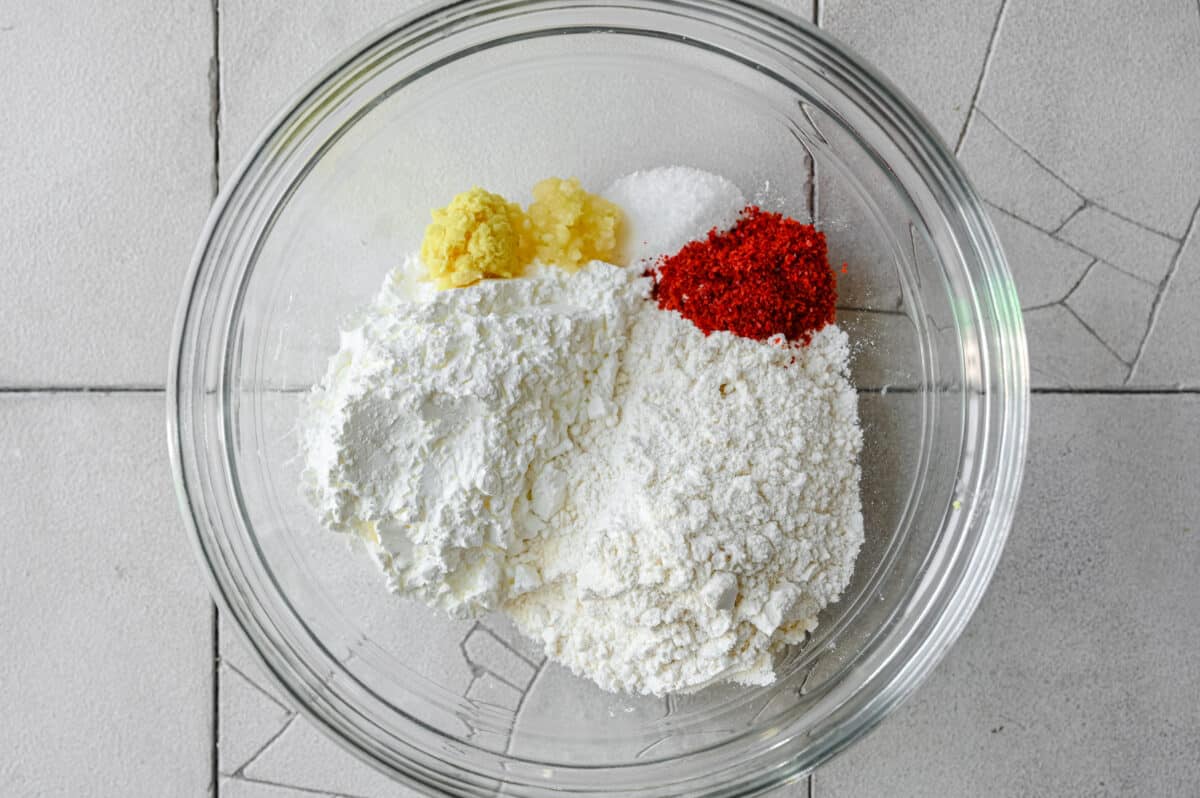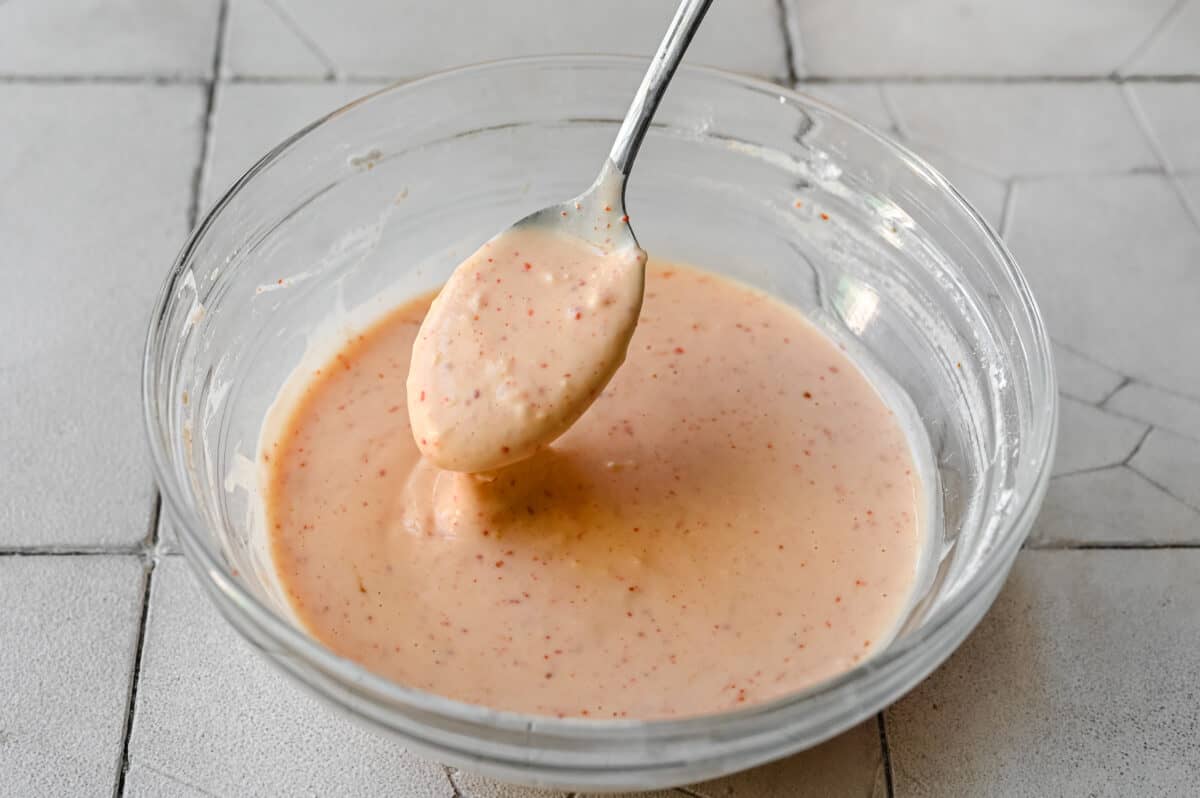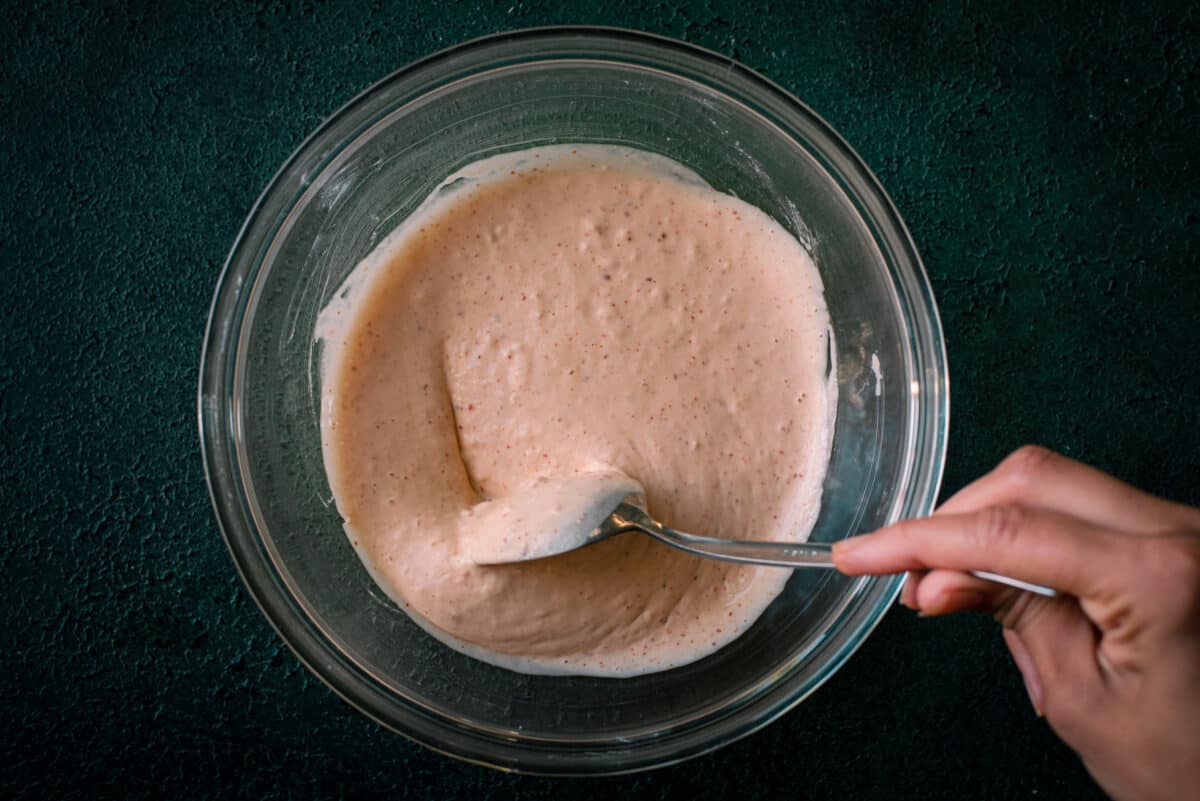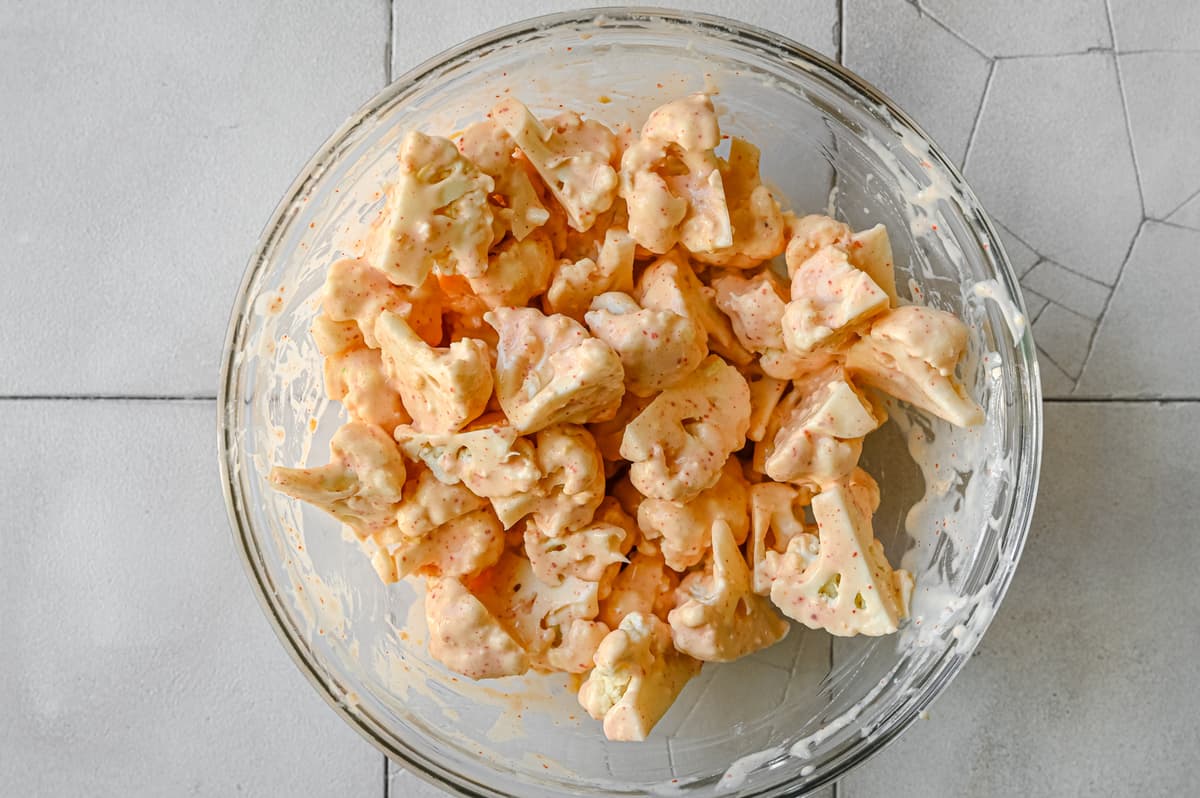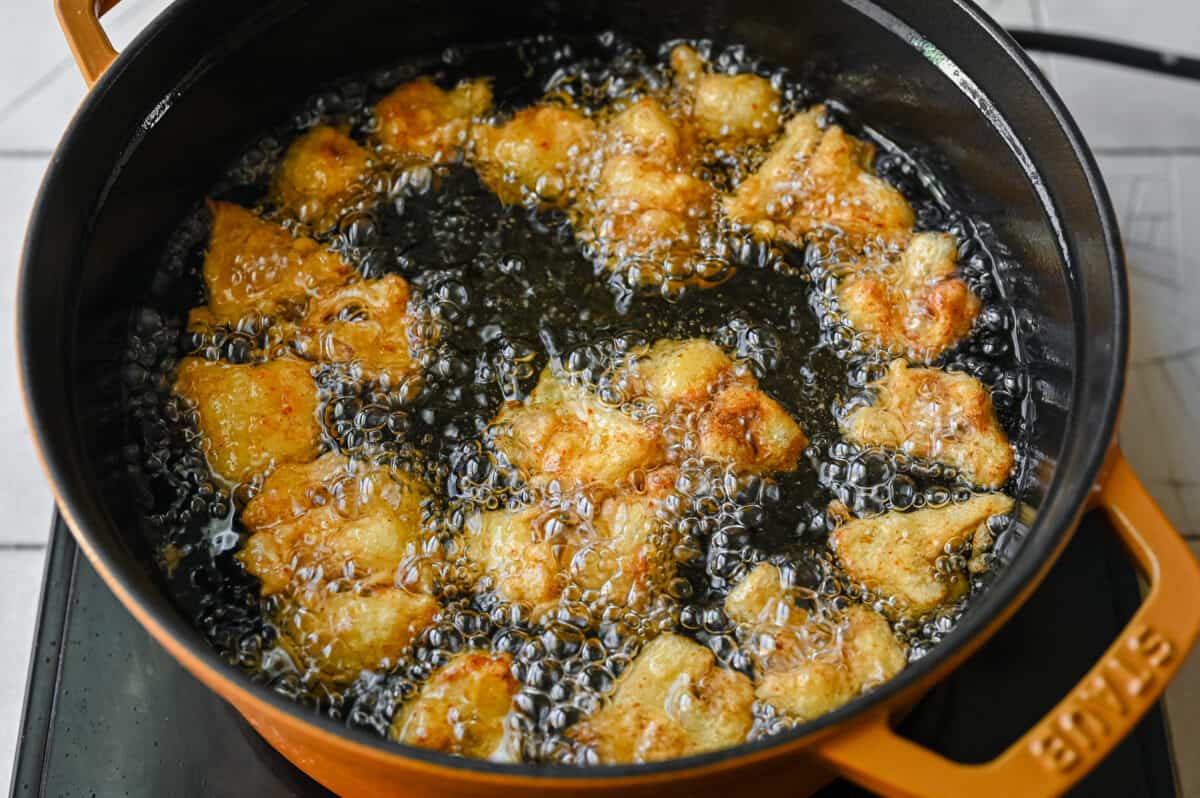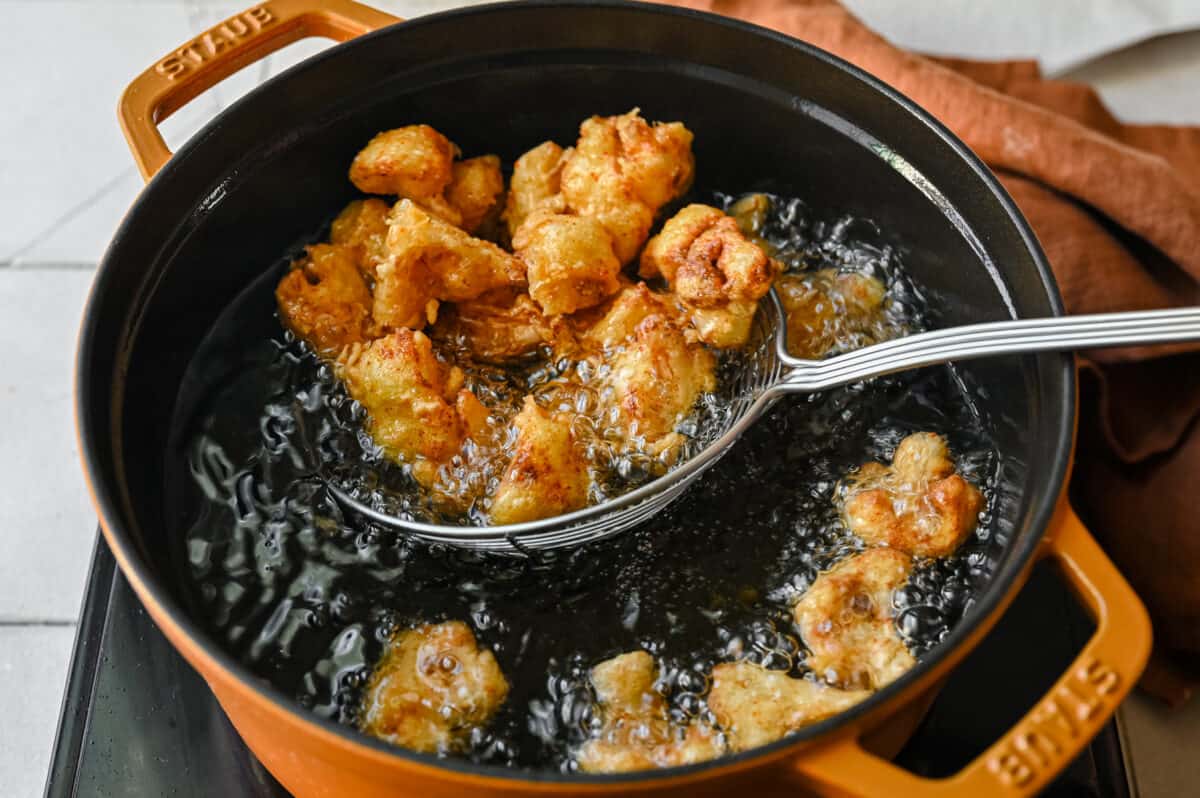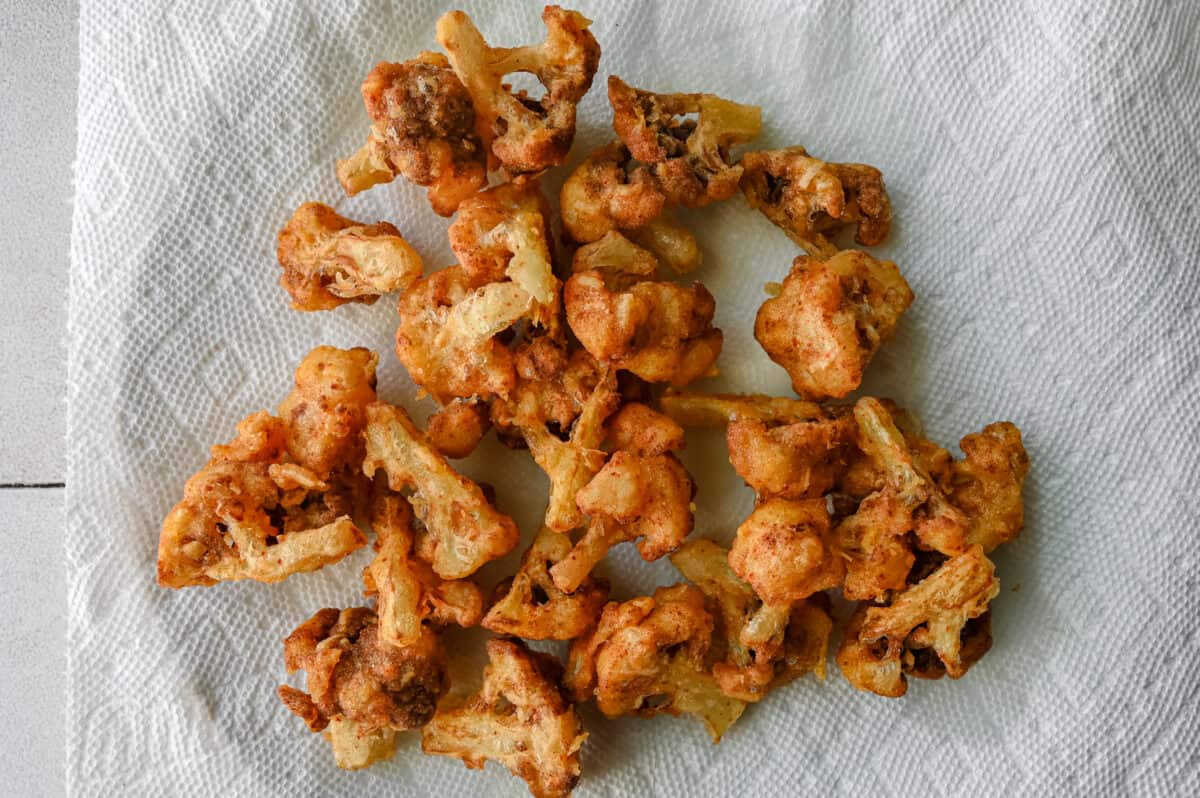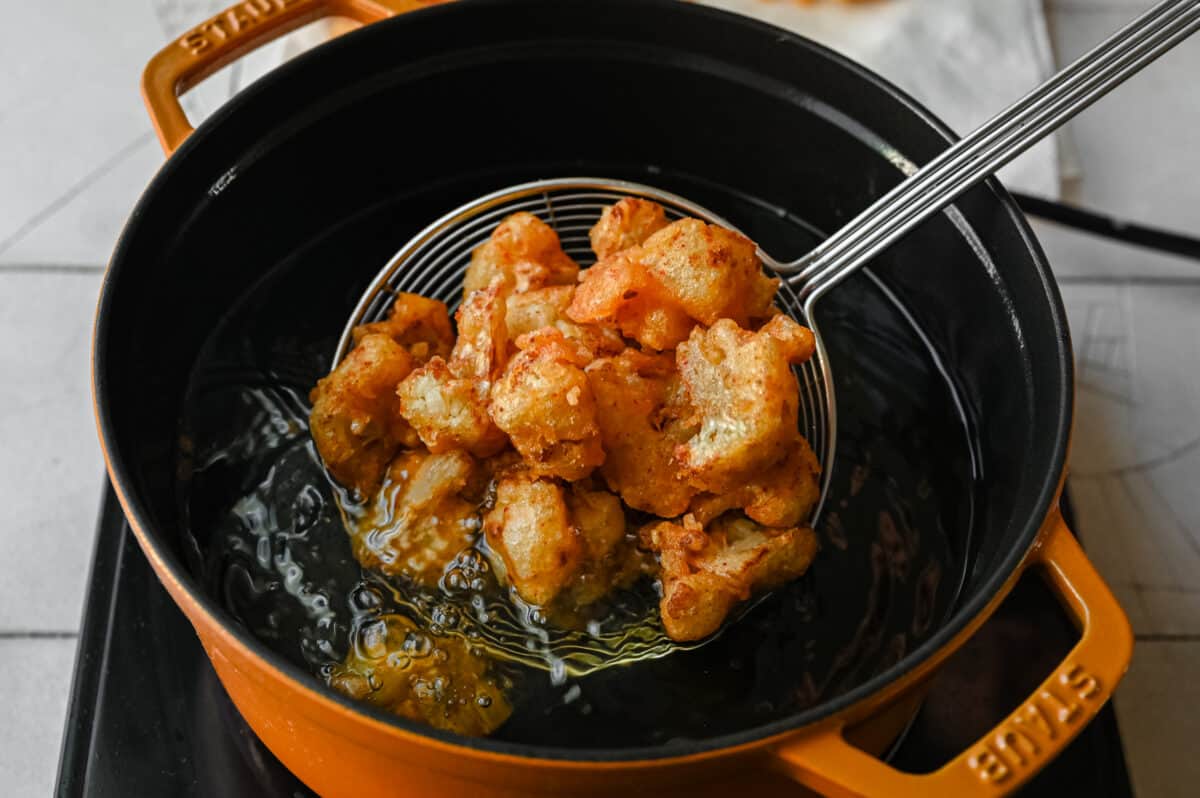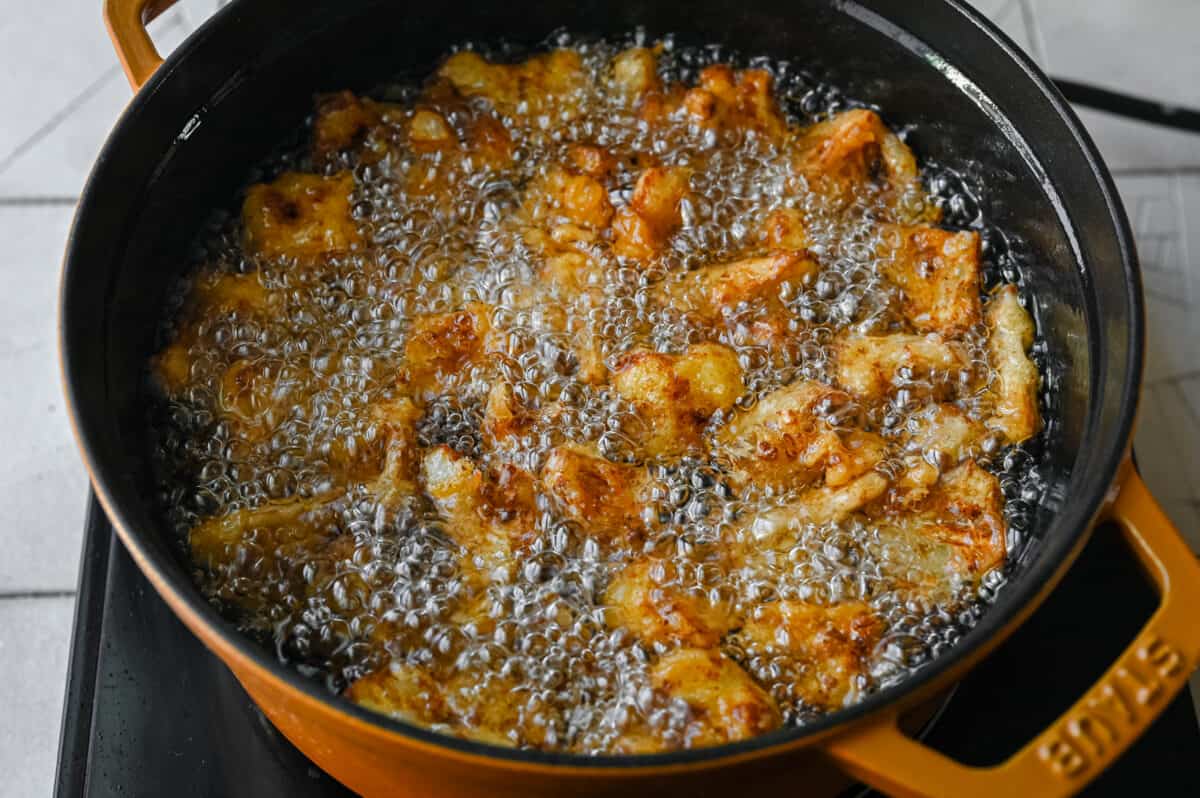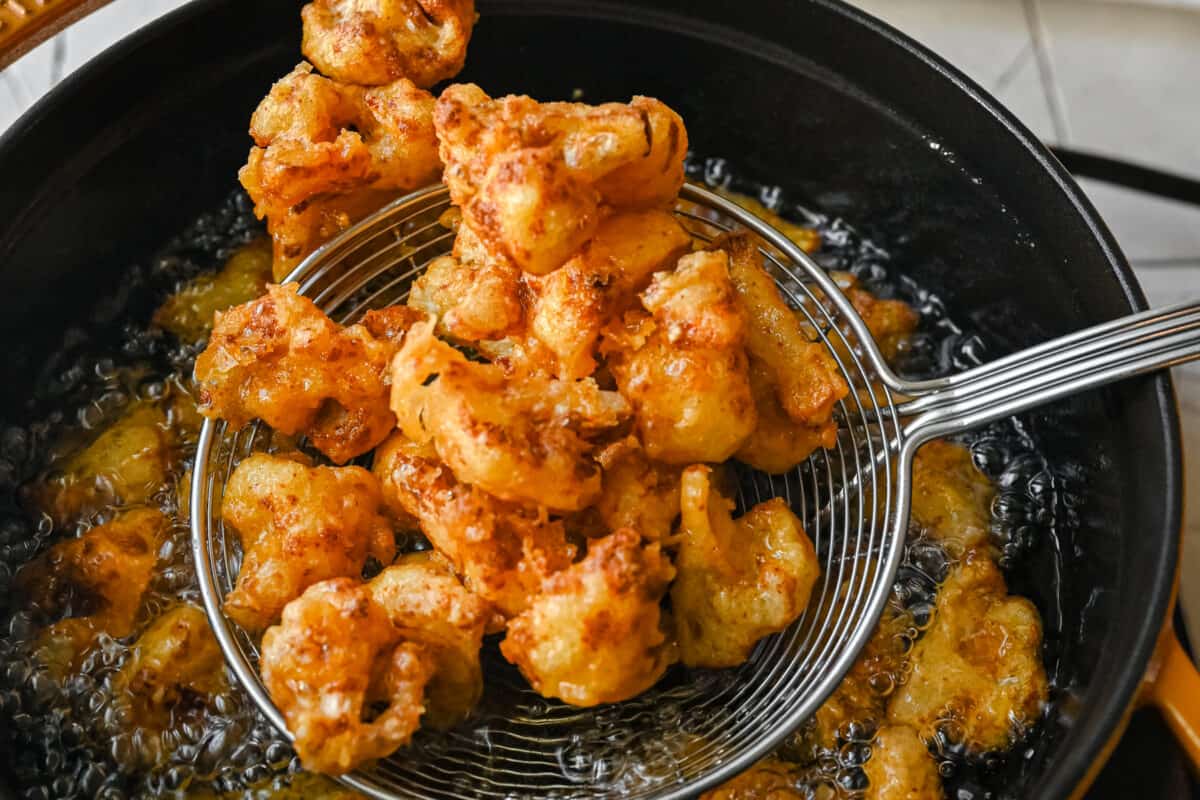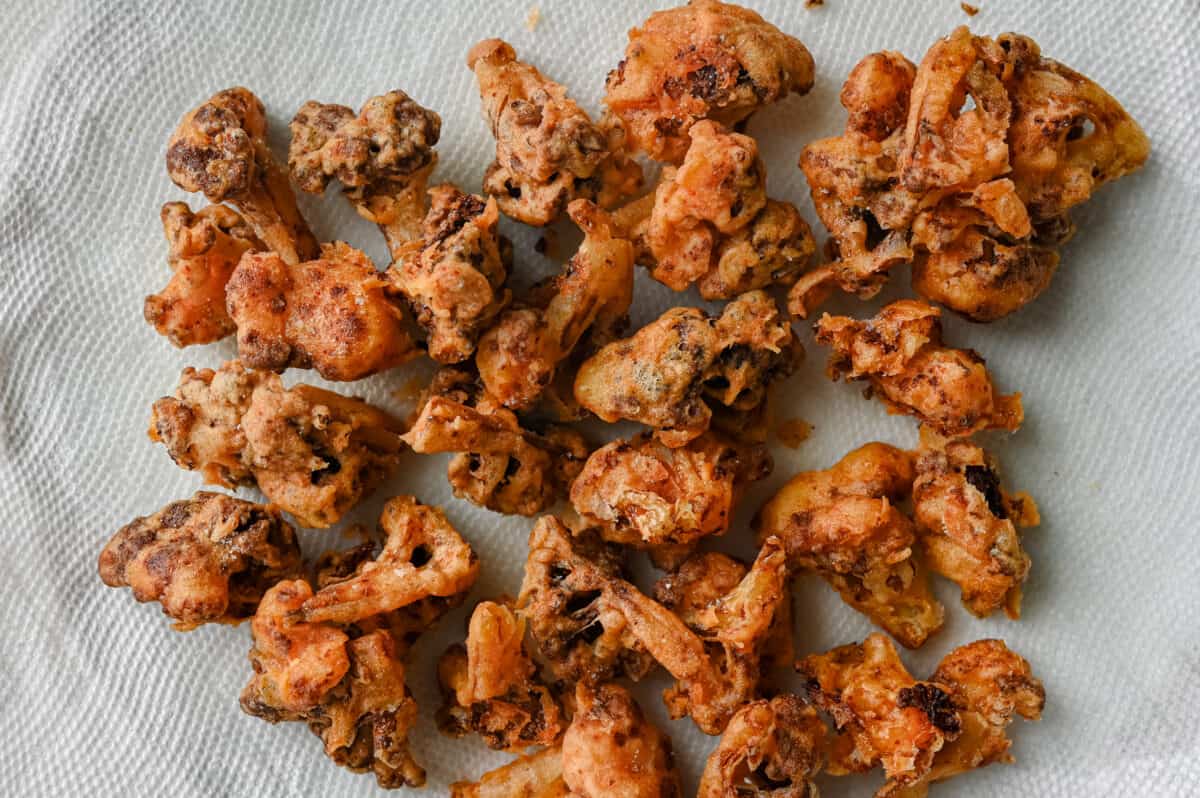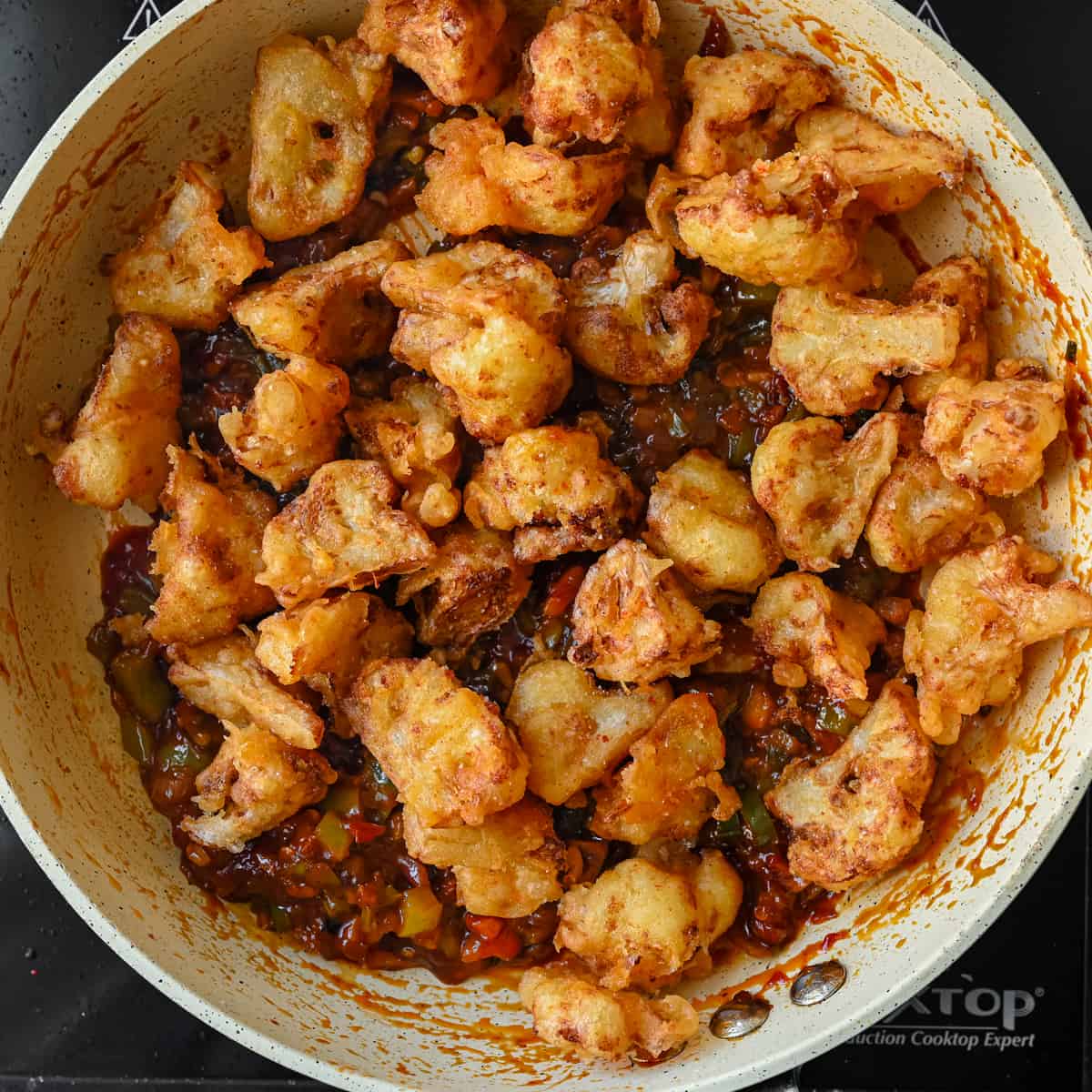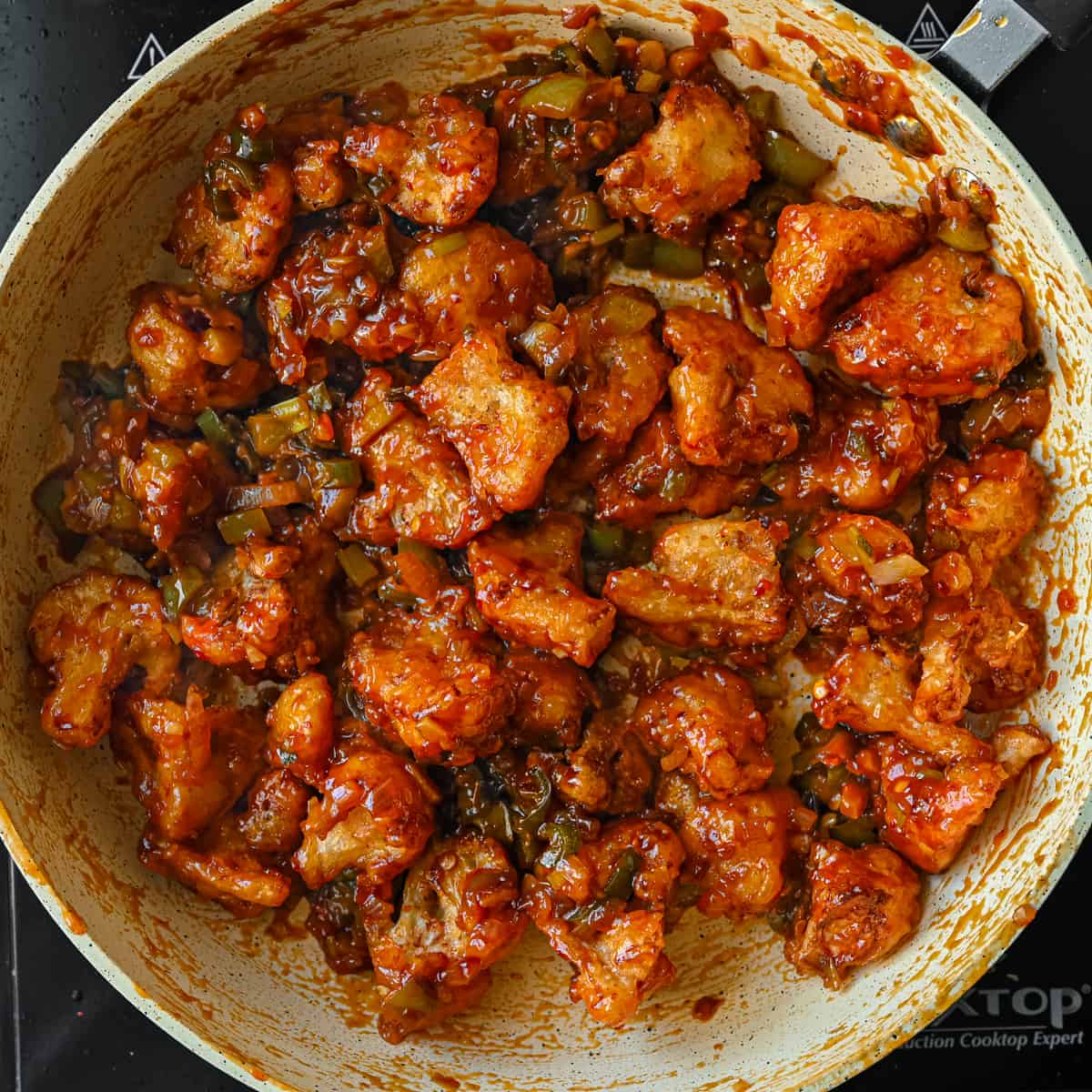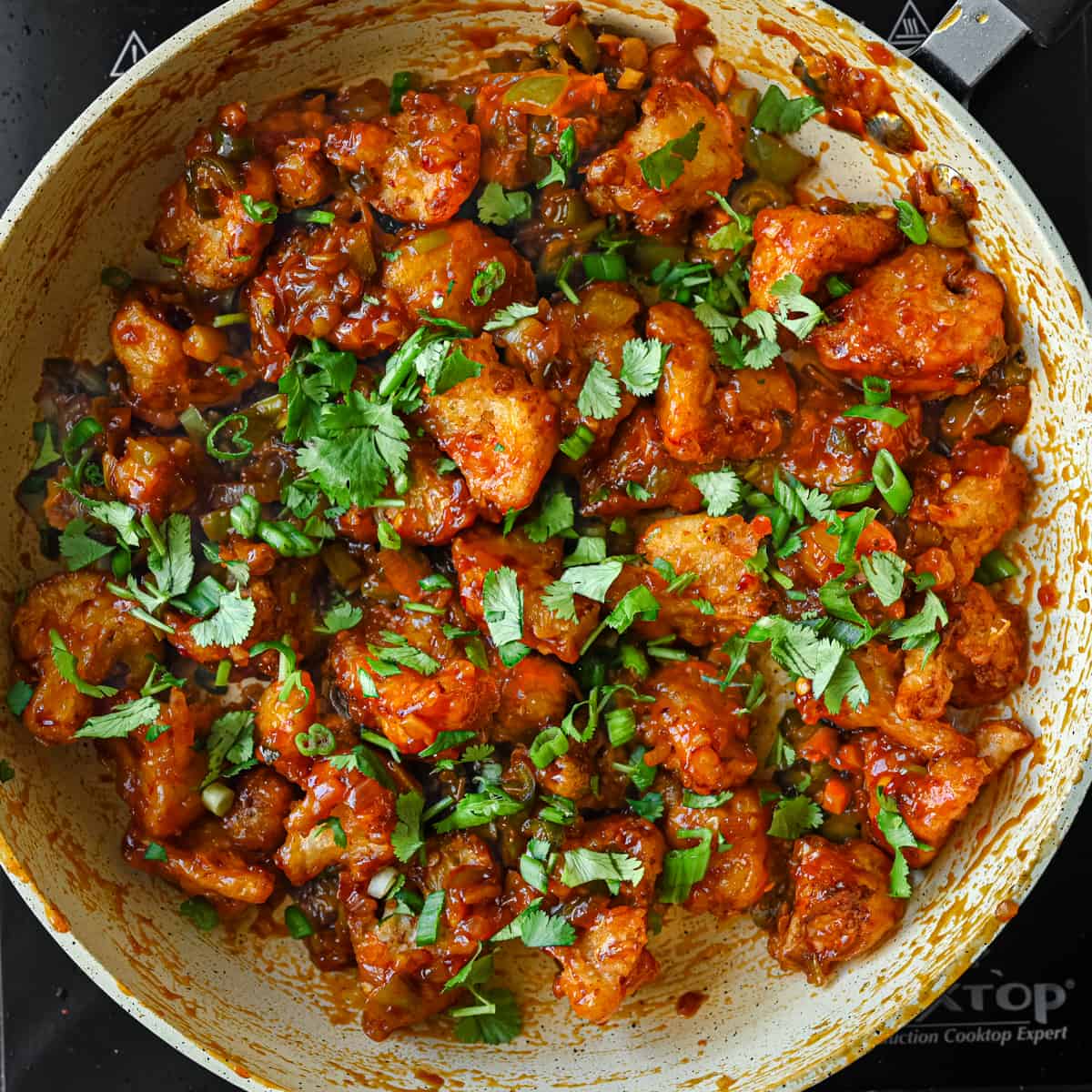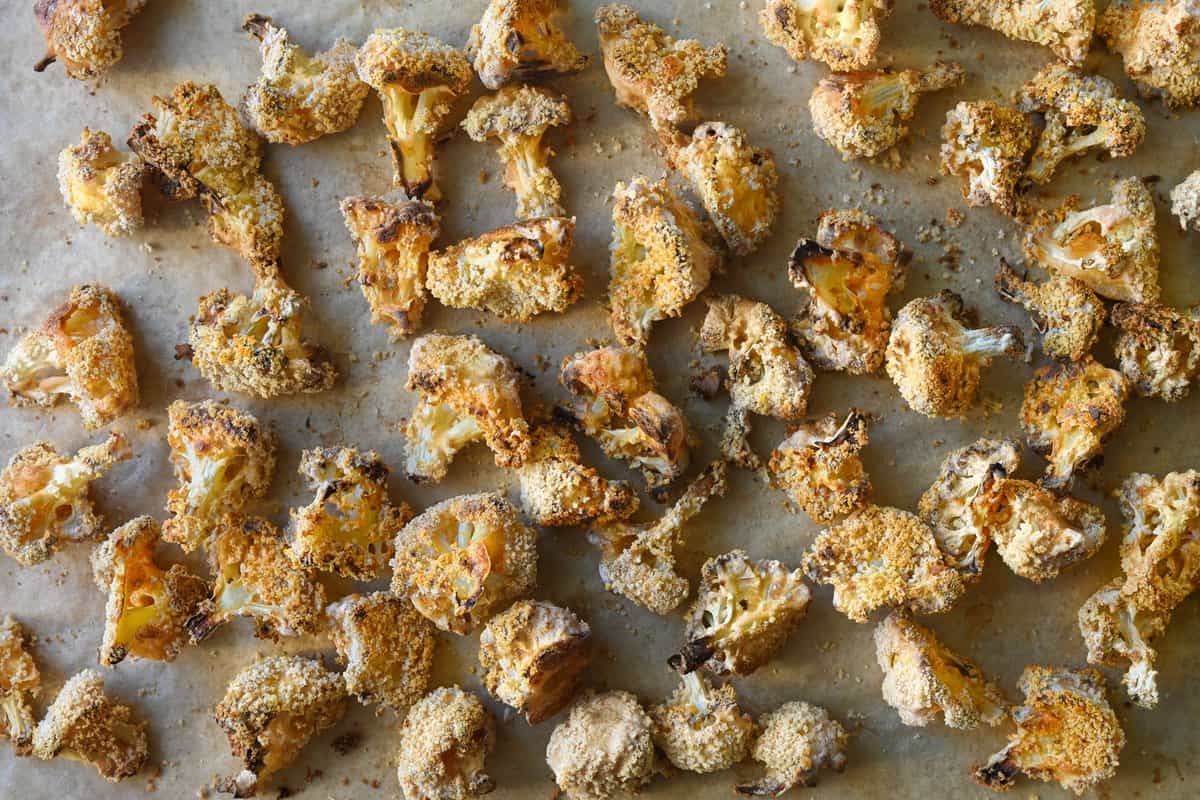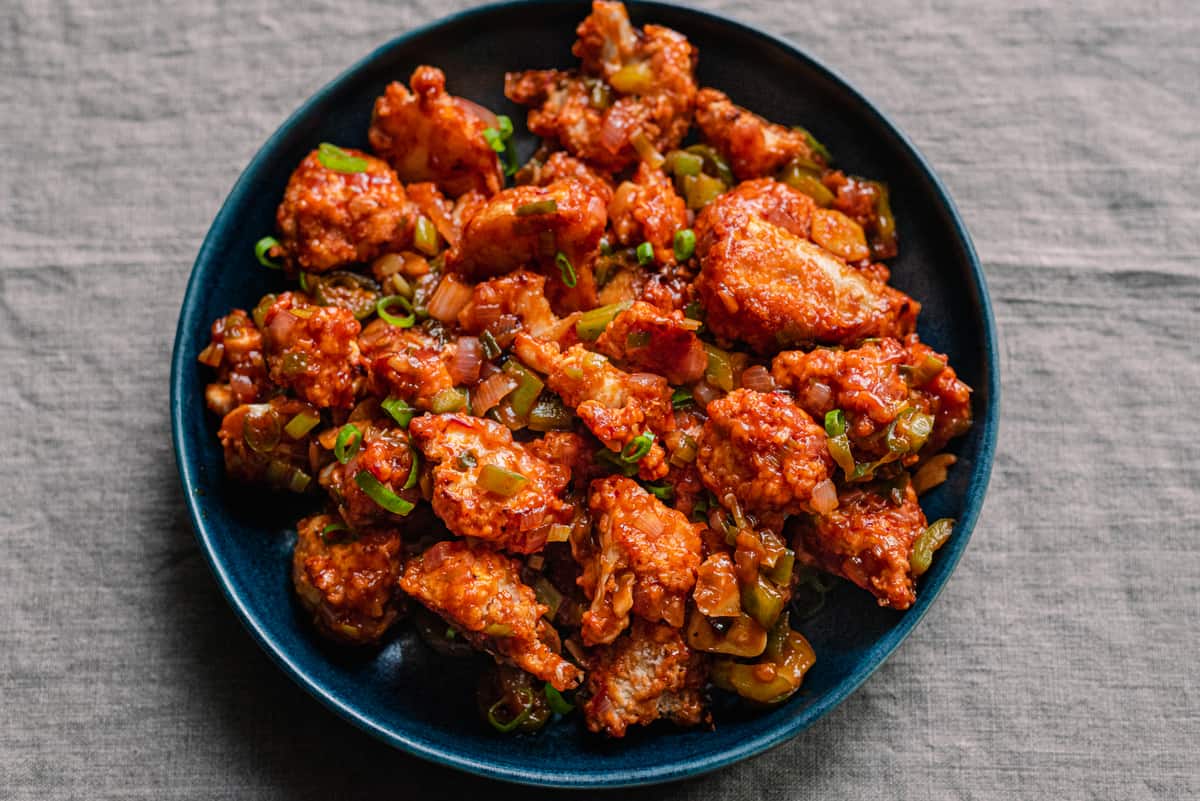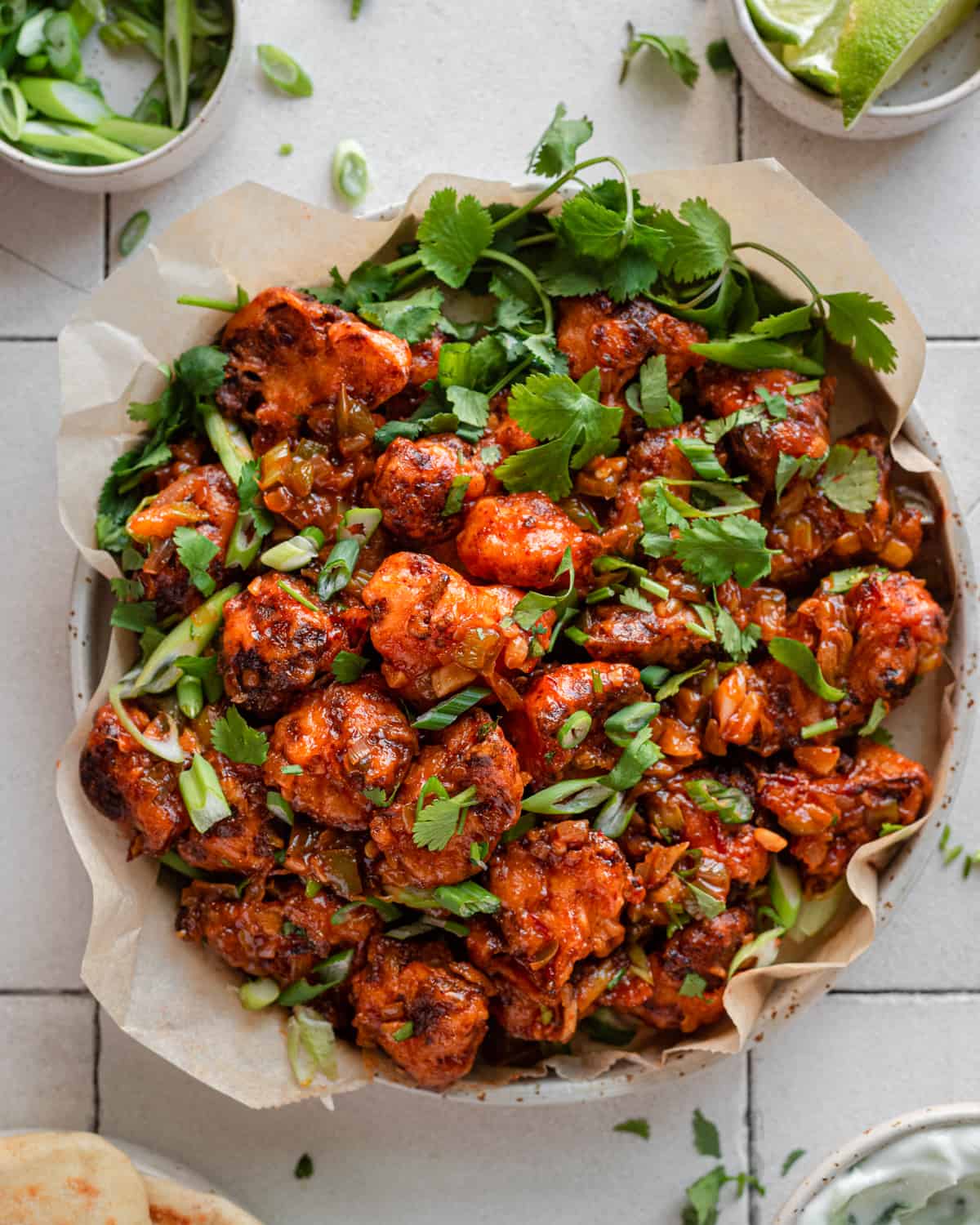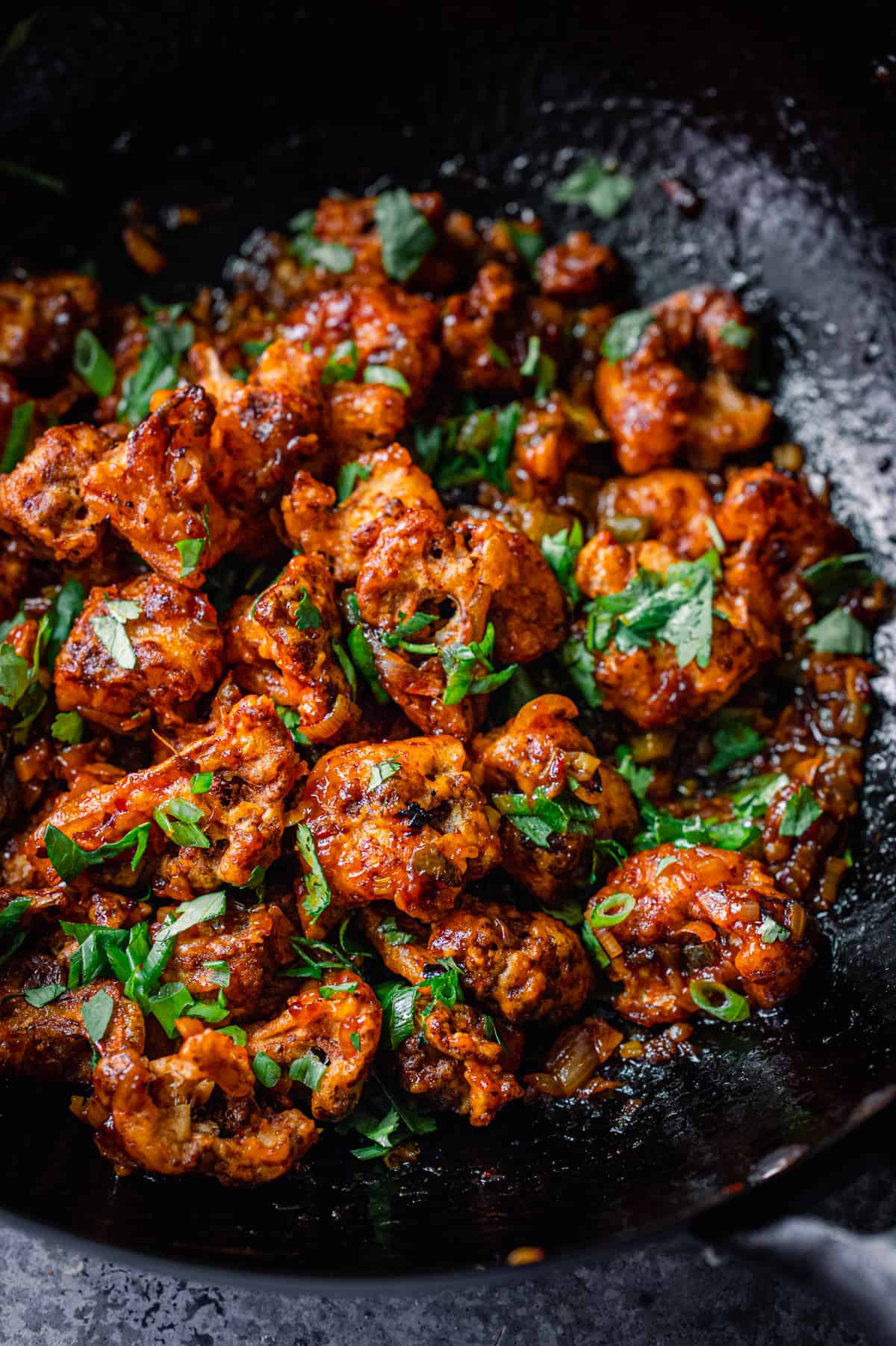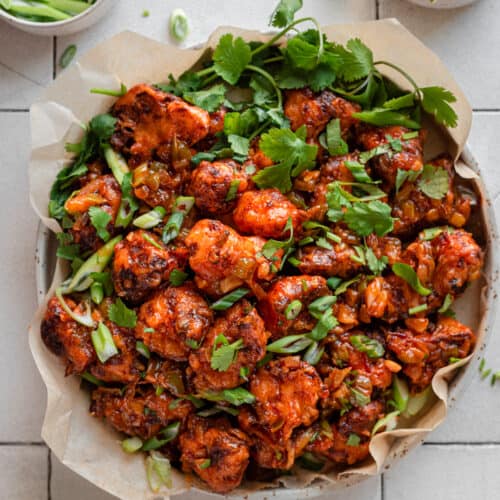It’s easily one of the best appetizers you’ll ever try and a must-make for your next party, game day, or any time you want to impress your friends and family.
What is Gobi Manchurian?
Gobi Manchurian is an Indian-Chinese dish beloved in India and among Indian food lovers everywhere. It features battered and deep-fried cauliflower (gobi) tossed in a flavorful sauce made with soy sauce, chili sauce, and a generous amount of aromatics (garlic, ginger, chili peppers, scallions, etc.). It’s naturally vegan and easy to make gluten-free. Indo-Chinese cuisine is the product of a very familiar immigration story. Several hundreds of years ago, Chinese migrants moved to India (primarily to Kolkata) seeking jobs. Many of them opened Chinese restaurants, but they soon realized they needed to adapt Cantonese cuisine to please the Indian palate, which has a predilection for spices and fried food. Indo-Chinese cuisine fuses Chinese cooking techniques (e.g., stir frying in a wok over high heat) and certain Chinese ingredients (thickeners like cornstarch and sauces like soy sauce and vinegars) with Indian aromatics, vegetables, and spices (e.g., garlic, ginger, hot chiles, onions, chili powder). The most common problem with Gobi Manchurian is that it’s often soggy, but if you follow these tips and this recipe, you’ll be treated to incredibly crispy Gobi Manchurian!
Should you deep fry or bake Gobi Manchurian?
If you’re interested in the best possible Gobi Manchurian, you’ll absolutely want to deep fry the cauliflower. Here’s why:
It’s one of the most delicious things you’ll ever taste and will transport you to food heaven.Deep frying yields cauliflower with a shatteringly crispy texture that will blow your mind. Since fat carries so much flavor, it yields a depth of flavor that’s not possible with the other methods. While deep-fried foods can be overly greasy, if you follow these instructions, this dish is not greasy. The hot oil heats the water in the cauliflower, essentially steaming it and giving it a crispy coating. If you’re nervous about deep frying, I’ve provided step-by-step instructions, photos, and tips that will make the frying process easy and straightforward. This is the traditional method of preparing this dish. If you’ve enjoyed Gobi Manchurian at an Indian restaurant, it was definitely deep fried.
With that said, I know deep frying isn’t the healthiest option. Gobi Manchurian is often served as party food and on special occasions, not as your weekly Tuesday night dinner. So if you wanted to make this for a weeknight meal with your family or plan to eat it often, the baked or air-fried versions are good options, even if they can’t hold a candle to the classic fried version. Summary: If you can, please make the deep-fried version. It’s worth it. If you plan to make this dish on a regular basis, though, the baked version or air-fried version might make more sense.
How to make this recipe (step-by-step photos)
Make the Manchurian Sauce.
Whisk together the soy sauce, chili sauce, ketchup, sugar, sesame oil, and vinegar. Heat the oil in a flat-bottomed wok over medium-high heat until it just starts to smoke, then add the oil. No wok? Heat a medium frying pan over medium-high heat for several minutes. Add garlic, ginger, and chili peppers. Stir-fry for 1 minute, shaking pan frequently, until garlic is golden but not brown. Add shallots, green bell pepper and scallions and stir-fry for 3-4 minutes. Pour in the Manchurian sauce. Stir-fry for 1 minute, shaking pan or stirring frequently. Add in cornstarch slurry (cornstarch + water) and stir, until the sauce turns glossy. Take off the heat and allow to cool to room temperature before adding cauliflower.
Batter the cauliflower
Note: these instructions apply to all cauliflower cooking methods: frying, baking, or air-frying. Cut your cauliflower into small-medium sized florets. Whisk together the dry ingredients for the batter: all-purpose flour or rice flour (GF), cornstarch, grated ginger and garlic, salt, and red chili powder. Gradually pour in the water, whisking as you go, until the batter is lump-free, thick, and viscous. Add a few florets to the batter and use a silicone spatula to toss the florets all over, coating all the crevices. Repeat with remaining florets, adding them in batches.
Fry the cauliflower
Note: baking and air-frying instructions can be found below.
Add enough oil to a saucepan or deep heavy-bottomed pan for deep frying.
Once the oil is at 340-350ºF (171-177ºC), transfer half of the battered florets to the oil. Do not disturb for 1 minute, then stir occasionally using a spider tool (affiliate link) or slotted spoon.
Fry until the florets are golden brown, 6 to 10 minutes. Scoop out and transfer to a paper towel-lined surface to blot away excess oil. Use your hands to pull apart florets that are stuck together.
Return the oil to the same temperature and repeat the frying process with the second batch of florets.
Increase the heat to high and bring the oil up to 375-400ºF (190-204ºC). Add all of the fried cauliflower and flash fry very briefly, 20 to 60 seconds, until golden browned.
Transfer to a new layer of paper towels and sprinkle with a bit of salt.
Note: This second “flash fry” ensures the cauliflower is extra crispy and stays crispy for quite some time. The oil needs to be very hot for this, and the florets turn deeply golden brown very quickly.
Mix the cauliflower and Manchurian sauce
Note: these instructions apply to all cauliflower cooking methods: frying, baking, or air-frying. When the Manchurian sauce is room temp, add the cooked cauliflower florets to the sauce and toss well to coat. Add the scallion greens and cilantro, and serve immediately.
How to make Baked or Air-Fried Gobi Manchurian
If you choose to bake or air-fry the cauliflower, please read these instructions.
General Notes
Both of these versions both work nicely, but the deep-fried version is hands down better. Eat these immediately; they get soggy quickly. The Manchurian sauce remains the same for all versions, whether you fry, bake or air fry the cauliflower. Rice flour: I don’t recommend it for the baked version; it came out gritty and toothsome. I haven’t tried it with the air-fryer method but it could be the same.
Air-Fried Gobi Manchurian
When air-frying, you will need to use significantly less cornstarch for the cauliflower batter. Do NOT use the measurements in the recipe card below—it will yield gummy cauliflower. Instead, use the below proportions for flour and cornstarch (all other measurements stay the same). ¾ cup (94g) all purpose flour 2 tablespoons + 1 teaspoon cornstarch Preheat your Air Fryer to 400ºF/200ºC for 3 minutes. Pull the basket from the air fryer and place HALF of the cauliflower florets in them. Slide it back in the air fryer and fry for 8 to 10 minutes. Turn the florets, then fry for another 8 to 10 minutes. Repeat with second half of cauliflower florets.
Baked Gobi Manchurian
Check out the second recipe card below for baking instructions. This is what the cauliflower florets should look like after baking. This is what the baked Gobi looks like once tossed in the Manchurian sauce.
Tips for making this recipe
Battering the Cauliflower
Make sure you pat dry the washed cauliflower. Water + hot oil are not friends. Slowly pour the water into the flour/cornstarch mixture. If you add it all at once, it will be lumpy and you risk it being too thin. The batter should feel a little gloopy with some resistance; otherwise, it will slip off the cauliflower. If it feels too thin, add a bit more all-purpose flour or cornstarch.
General Advice for Deep Frying
Tools. You need a slotted spoon or spider/skimming tool (affiliate link). Ideally, 2 pairs: one for lowering the battered florets into the hot oil (which will have batter stuck to it) and one for stirring and removing the florets from the oil. In a pinch, a set of long tongs can be used, but it’s more cumbersome.
A probe thermometer is also very helpful (we love this one) (affiliate links).
For the pan, stay away from shallow pans and instead use a pan that has high sides. A small Dutch oven works great (I use my 4 quart cast iron Staub Dutch Oven – affiliate link). This helps keep oil splatter to a minimum and ensures the oil doesn’t bubble over. If you have a cast iron or enameled cast iron pan with deep sides, these are great choices, as they retain heat well.
Type of oil. You can use vegetable oil, avocado oil, sunflower oil, soybean oil, grapeseed oil—any neutral-flavored oil with a high smoke point of at least 400ºF. Do not use olive oil.
Amount of oil. You will need a fair amount of oil, enough that you can submerge the florets. The smaller the pan, the less oil you’ll need.
Safety tips: Don’t fill up your pan too high with oil, no more than 1/2 full with oil. Adding too much oil can cause it bubble over, which can potentially cause a grease fire. Do not get any water near the hot oil. If water mixes with hot oil, it can smoke, so cover the pan with a lid or baking sheet.
Temperature of oil. Wait until the oil comes up to the listed temperature. Otherwise, the cauliflower will not get adequately fried and will become soggy when tossed in the sauce.
How to test if your oil is hot enough, without a thermometer: Add one cauliflower floret to the oil: it should bubble up immediately. Or, add a cube of bread: it should turn golden in 25 to 30 seconds. Depending on the size of your pan, it should take (a) 12-15 minutes for the oil to reach the initial 340-350ºF temperature; (b) 1 to 2 minutes for the oil to return to this same temperature after removing the first batch of cauliflower; and (c) 3 to 6 minutes for the oil to reach 375-400ºF for the final flash fry.
Frying the Cauliflower
Fry in two batches. If you add the florets all at once, they’ll crowd the pan and won’t fry evenly. Get properly battered florets. Don’t stir the florets during the first minute (the batter can slip off them). Some florets will stick together— don’t worry. You can easily pry them apart after they’re done frying and cool enough to touch. Fry at the right temperature. The first fry happens at a lower temperature to ensure that raw cauliflower cooks through on the inside before it browns. If you notice the cauliflower browning very quickly, lower the heat a bit. The flash fry happens at a higher temperature since the cauliflower is already cooked. Wait until golden brown. During the first fry, wait until the cauliflower is golden brown to remove it. The exact time depends on the size/shape of pan and how much oil you’ve added. During the flash fry, wait until they’re deeply golden brown (if using rice flour, this takes just 20ish seconds). Don’t fry the cauliflower too far in advance to maintain maximal crispiness.
Making the Manchurian Sauce
Tools. A wok is the traditional method of making this sauce, as with any Chinese stir-fry. If you don’t have a wok, though, a medium frying pan works fine. Mis en place and work quickly. Like any stir-fry, you need to prep all your sauce ingredients and have them ready, as the aromatics and sauce cook quickly. Prevent sticking. When using a wok, heat it until it just starts to smoke. Then add the oil. This method ensures the ingredients don’t stick to the wok. Keep the sauce at room temperature. In our many tests, we found that adding the fried cauliflower to a hot-temperature sauce makes the cauliflower get soggy quickly. Adjust to your spice tolerance. Since we love spicy food, we opt for the very spicy version. Mild heat: omit the serrano peppers. Moderate heat: use 1 serrano pepper, remove the membranes. Very spicy heat: use 2 serrano peppers with membranes intact. Tip: If you are very sensitive to coughing, omit the serrano peppers entirely. But if you want more spiciness, use 2 or 2 ½ tablespoons chili-garlic sauce instead of 1 ½ tablespoons.
More delicious vegan Indian recipes
Vegan NaanTofu Tikka MasalaDal TadkaVegan Palak PaneerVegan Curry with Tofu
If you love this Gobi Manchurian recipe, please give it a rating and review below! And of course, tag me with your remakes on Instagram!
Big Vegan Flavor
Techniques and 150 recipes to master vegan cooking.
Big Vegan Flavor
Techniques and 150 recipes to master vegan cooking.
